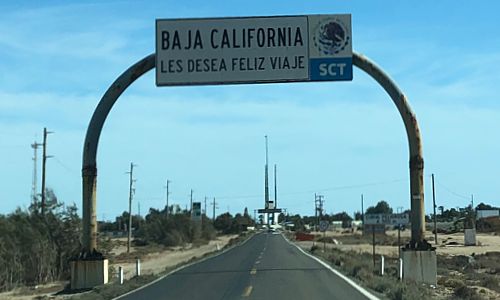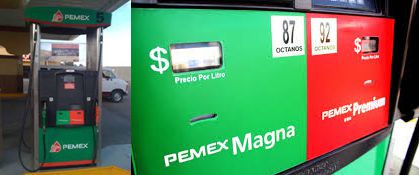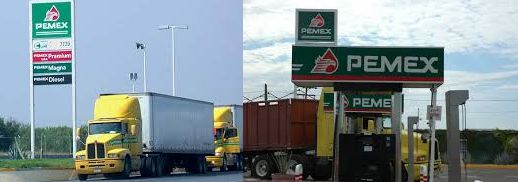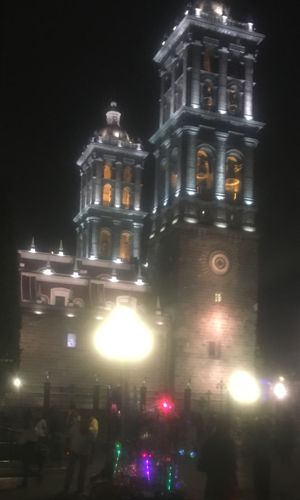Driving and Safety Tips for Mexico
By Alan Kohl
With more than 40 years experience driving in Mexico while living and working there and as a tourist, I have learned a fundamental rule of driving in Mexico: EXPECT THE UNEXPECTED! Most accidents involving visitors to Mexico are a result of the visitor not expecting or anticipating an unaccustomed or sudden change in traffic or road conditions.
Highway Driving

For tourists, the single biggest cause of motor vehicle accidents on the highway in Mexico is the narrow roadway with almost no shoulder. If there is a shoulder at all, the drop-off from pavement to shoulder is usually several inches, so when a right side wheel drops off the pavement it almost certainly results in an accident, with the vehicle very frequently rolling over, causing significant damage to the vehicle and injuries to the occupants.
Even if the vehicle doesn’t flip when a wheel drops off the pavement it frequently results in slicing the inside sidewall of the tire.
If you are towing a trailer, especially a long trailer, even more care is required on sharp right hand turns in which the trailer tires track inside of the tow vehicle’s turning trajectory.
This kind of accident is avoidable. Driver attention is enormously more important in Mexico because the roadways are much less forgiving than the wide, four lane highways with wide shoulders off the pavement that we are spoiled with in Canada and the US.
On a recent trip to Mexico we were traveling on a typical two lane highway, towing our camping trailer. Out of curiosity I stopped and measured the pavement from the center line to the right hand edge of the pavement: The lane was 11 feet six inches wide with an immediate 6 inch drop off the pavement on the right side.
Our trailer is 8 feet 4 inches, meaning that when driving down the middle of the lane (at 60 miles per hour) there was exactly 18 inches to spare on either side of the vehicle. By comparison, the Interstate Highway system in the U.S. has over three feet of tolerance on each side of the vehicle, with no drop off on the right side.
Besides driver attention, here are a few other pointers that may make your Mexican trip safer:
- Be positive your vehicle is in top mechanical condition, especially the suspension and tires.
- If you plan to drive at night, be sure the headlights are properly aligned for best lighting results.
- Understand the width of your vehicle vs. the width of the highway you are traveling in Mexico. This is even more important if you are towing a trailer that is wider than your tow vehicle.
- Don't drive as fast on two lane highways in Mexico as you would on two lane roads at home.
- Slow down when you enter small towns in Mexico, being watchful for pedestrians, dogs, buses, carts and bikes.
 Topes Sign, the famous Mexican Speed bump. They are frequently unmarked, except by skid marks. They usually appear “out of nowhere” when entering and leaving small towns.
Topes Sign, the famous Mexican Speed bump. They are frequently unmarked, except by skid marks. They usually appear “out of nowhere” when entering and leaving small towns.- Avoid driving at night in Mexico, but if necessary, wait outside a town for one of the many highway buses to go by, and then follow it at a safe distance of 50 yards or so. Let the bus run interference, and allow sufficient room to stop if necessary.
- If you don’t have a turning lane, don’t make left turns off major Mexican highways if traffic is coming up behind you.
- Be especially vigilant for very slow moving vehicles, at any time.
- At night, don’t be surprised to overtake a slow moving vehicle with no lights showing from the rear.
- Don’t rely on brake lights on the vehicle in front of you as the only warning it is slowing down. They may not work.
- If you have a choice, take toll roads (Cuota) and avoid the free (“Libre”) roads. Toll roads are wider and in better condition.
Mexico’s “Green Angels” help motorists
 Mexico’s Department of Tourism operates a fleet of trucks like the one pictured here, whose purpose is to help motorists with roadside mechanical problems. They travel all main highways in Mexico at least two times daily. The drivers are polite, professional, and bilingual.
Mexico’s Department of Tourism operates a fleet of trucks like the one pictured here, whose purpose is to help motorists with roadside mechanical problems. They travel all main highways in Mexico at least two times daily. The drivers are polite, professional, and bilingual.
If you are out of gas, have a flat tire, or a mechanical problem, the Green Angels will fix the problem or arrange for reliable assistance to get you back on the road.
To reduce the wait time to get help from a Green Angel, just dial 078 to connect to the Green Angel help line. You can see the 078 number painted in red on the back of the truck in the photo above. You will be asked to provide the highway number, kilometer marker, and direction of travel.
P.S. If you receive service from a Green Angel, don’t forget to offer a gratuity to show your appreciation.
City Driving
 "Alto" means STOP
"Alto" means STOP- Understand one-way street markings. Some helpful hints for driving on Mexican roads:
- The one-way signs in Mexico are usually attached to buildings 10 feet or so above ground level.
- The signs in Mexico are only about five inches high x 2 feet long and easy to miss.
- Streets going in the direction of the Green → arrow have the right-of-way.
- Streets going in the direction of the Red → arrow must yield the right-of-way.
- When in doubt, it’s always safer (and smarter) to yield.
- An excellent tool is an App on your "Smart Phone" - Google Maps!
- Study the way. If you get lost, do not go around. Pull over and try to orient yourself.
- If you can not orient yourself, consider asking for a taxi and follow it, and then pay when you arrive at your destination.
- Watch for pedestrians, carts and bicycles.
- Understand the flow in traffic circles/roundabouts.
Are You Driving A Diesel Fuel Vehicle?
 In Canada and the U.S., the pump with the green handle is diesel. NOT SO IN MEXICO..
In Canada and the U.S., the pump with the green handle is diesel. NOT SO IN MEXICO..
Pemex stations usually have two service areas separated by a considerable distance, and usually on opposites of the station. One service area is strictly for gasoline and the other is strictly for diesel. Pemex does not dispense gasoline and diesel from the same fuel island.
 Shown to the right, the green pump handle is for Magna, or Regular grade gasoline while the red pump handle is for Premium grade gasoline.
Shown to the right, the green pump handle is for Magna, or Regular grade gasoline while the red pump handle is for Premium grade gasoline.
If you are driving a diesel, be sure to drive to the diesel service area, where the signs and pumps are black.
Putting the wrong fuel in your vehicle is both expensive and inconvenient, so it pays to be cautious and understand how things work at Pemex stations.
Vehicle Theft
Vehicle theft is as much a problem in Mexico as in the U.S. and Canada. The difference is that a stolen car at home isn’t nearly as inconvenient as it is while traveling in another country. Here are some tips that may help you protect your vehicle and save a lot of aggravation:
- If your vehicle is equipped with an anti-theft alarm, USE IT!
- Tourist vehicles are targets, and are easily identifiable from local vehicles.
- Avoid on-street parking if at all possible.
- Use paid parking lots where available and DO NOT leave the parking ticket in your vehicle.
- The bigger the Mexican city, the greater the risk.
- The large Mexican border cities are especially problematic.
- If you must park on-street, try to keep your vehicle in sight or check on it frequently.
- Stay in hotels and motels that offer 24 hour security in a secure parking area.
Logically, most people leave their Mexican auto insurance policy in their vehicle, right? But what if your vehicle is stolen? On a separate piece of paper, write down the name of your Mexican auto insurance company, your policy number, and the 800 telephone number of your Mexican insurance company to report claims. Keep this information in a wallet or purse so you will have it in case your vehicle and insurance policy are stolen.
About Security in Mexico
I am often asked about personal safety in view of violence associated with narco-trafficking in Mexico. I begin my response by asking three questions?
- Is your trip to Mexico related to narco-trafficking?
- Is your trip to Mexico related to money laundering?
- Is your trip to Mexico related to the sale or trafficking of firearms and/or ammunition?
If your answers to the above questions are “NO”, chances are you won’t be in any more danger in Mexico than you would be in the U.S.
It is well documented that the violence is between cartels fighting each other for distribution routes, and between the cartels and Mexican law enforcement. Thus the three questions above. Civilians, whether Mexican or foreigners, have not been targeted, except in error.
True, innocent by-standers have found themselves in the wrong place at the wrong time, but these situations have been as rare in Mexico as they are in the U.S. On a couple of occasions we read about an “American” being shot in Mexico. Looking deeper, it’s not uncommon to learn that this person has a Hispanic surname, leading one to speculate that he/she may have been involved in trafficking.
We continue to travel throughout the U.S. and Mexico. As a result of crime in both countries we have become more careful and we practice situational awareness with greater diligence . . . on both sides of the border. And, we do not feel any safer on one side of the border or the other.
Military Checkpoints
As you travel in Mexico you are likely to come upon military checkpoints on the highway, usually on northbound routes. Do not be alarmed. In all of our travels in Mexico we have consistently found these soldiers to be polite, courteous, professional, and efficient as they go about their job of looking for drugs and firearms. Once they complete their inspection we often engage them in conversation and always find them to be quite friendly.
As we approach these checkpoints we lower all the windows in our vehicle for easy examination. I unlock the tool box permanently mounted in the back of our pickup. If there is nothing to hide, making it easier for the soldiers to do their jobs puts them at ease and saves time for everyone.
When traveling north you will likely be asked to step out your vehicle so it can be searched more thoroughly. In this situation, common sense says don’t leave valuables such as wallet, purse, cell phone, or cash in the vehicle as you dismount. We have never had a problem with this, but it why tempt fate?
In General

- Use common sense.
-
Pesos vs. Dollars: Simplify your life and your stay in Mexico! Mexico’s currency is the Peso, so it is much, much easier to pay for your purchases with Pesos.
Don’t be confused: the $ symbol for the peso and the dollar are identical.
If you do pay in dollars you will probably pay more because you are giving the merchant, gas station attendant, or clerk at the point-of-sale the “privilege” of setting the exchange rate.
It doesn’t get much more confusing than when buying gas with dollars - converting dollars to pesos and liters to gallons!
- A good place to buy pesos is the ATM machine inside banks. We find that Bank ATMs give good exchange rates and they are safer. We avoid using ATMs in super markets, convenience stores, and hotels. Hotel cashiers usually offer terrible exchange rates.
- Remember, you are a visitor in Mexico and things may be done a little differently than at home.
- A smile and a friendly attitude go a long way toward gaining cooperation and friendship.
- If speaking English to a non-native-English speaker, speak slowly and clearly and avoid using slang.
- If you have questions perhaps we can help.
Reporting a Claim
If you have an accident or insurance claim in Mexico, it must be reported as soon as possible and it must be reported to your Mexican insurance company before you leave Mexico. Failure to do so can result in your claim being denied because, logically, the insurance company would be deprived of the opportunity to investigate the incident.
Your insurance policy contains a page titled “What to do in Case of an Accident”, which includes step-by-step instructions what to do and includes a 24/7 toll free telephone number to call to report or seek assistance.
Your claim will be attended by an insurance adjuster dispatched by your Mexican insurance company. The insurance adjuster will complete a written report detailing circumstances and damage to your vehicle. You will be asked to sign the insurance report, so to avoid discrepancies later, be sure you understand what you are signing.
Make sure all damaged parts of your vehicle are noted on the insurance adjuster's report. If your vehicle left the highway during the accident, check for damage underneath it and make sure it is noted in the insurance report.
Be sure you receive a copy of the claim adjuster’s report before you leave Mexico. The claim report will contain the Claim Number, which will be needed for future reference and communication regarding you claim.
Have a safe trip and be sure to enjoy all of Mexico’s natural, historical and cultural beauties.
© Mexico Insurance Intermediaries, LLC (revised March 2024)
5460 N Blue Bonnet Rd, Tucson, AZ 85745-9617 (Business Office, not a retail location)
Website designed and maintained by: Creative Aerts, Inc.